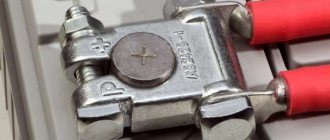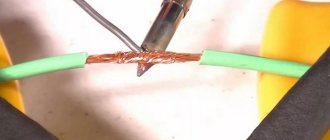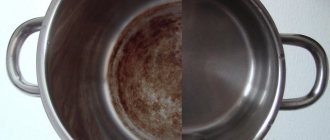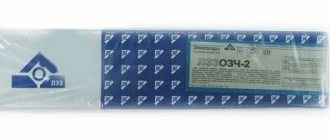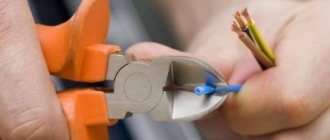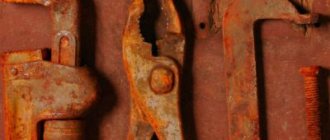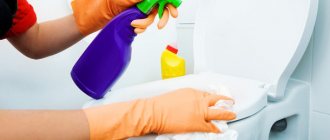The computer stopped turning on or the hard drive was detected? Does the BIOS show less RAM than it actually has? Does your phone glitch when charging? You can do without buying new components or going to a service center. After all, the common expression “electrics is the science of contacts” is true.
Often the problem lies in a missing connection on the contact pads. Especially when electronics are used for a long time in a room with sufficiently humid air. Over time, under the influence of voltage and microdroplets of water, the contacts oxidize. After eliminating the layer of metal damaged by the chemical reaction, I was able to force several “system units” to turn on and revive many “dead” hard drives that completely refused to be read.
This saved me tens of thousands of rubles and even brought me additional income. Recessed smartphones can also be disassembled and cleaned at home - the technical process is more complicated than with larger equipment. Devices can often be brought back to life even by a non-professional. Then the gadgets function, albeit sometimes with some glitches, depending on your luck.
Contact oxidation occurs due to its contact with oxygen or another metal. The oxidized layer has low electrical conductivity.
How to clean the charging contacts on your phone?
A dirty USB connector can lead to problems with charging, as well as with connecting to a computer. There are four easy ways to clean it:
- Piece of paper.
- Needle.
- Brush.
- Alcohol.
- Compressed air.
In principle, they can be used sequentially.
First stage. Plain paper. Tear off a piece from an A4 sheet, fold it in half or in four to form a pointed corner. Insert it into the connector, carefully cleaning out any dirt. This is a method for field conditions when there is nowhere to get a needle and brush.
Second phase. Thin needle. A regular sewing needle or a needle from a medical syringe will do. Simply blow off the removed dirt onto the table.
Third stage. Fine cleaning with a brush. Its pile should penetrate into the nest, reaching the most secluded corners. Use a cosmetic or old toothbrush with medium hardness. Place the lint inside the connector and clean it. No hard brushes or sudden movements - spare your smartphone and your own money.
Fourth stage. Cleaning with alcohol or alcohol-containing liquid. Take the phone vertically and pour liquid with a pipette or syringe into the connector in a stream from bottom to top. The excess will drain. Dry with a hairdryer on low power. Once dry, test by connecting the cable to the charger.
Fifth stage. A compressed air cylinder for contactless cleaning of dust from electronics. “Blow” the can into the connector several times and the dirt will fly out.
The order of the steps can be changed at your discretion. And a few caveats:
- Avoid applying pressure to avoid damaging the connector.
- Do not use aggressive liquids instead of alcohol, which may react with plastic.
- Do not use hard brushes, thick needles, paper clips or toothpicks.
To protect the connector, you can buy plugs on Aliexpress. They will prevent clogging. Cost - within 80-100 rubles.
Dust plug for headphones and USB phone
For cleaning, I recommend using antistatic ESD brushes.
Antistatic brushes for electronics
On a laptop
How to lubricate the battery terminals so as not to oxidize, for better contact?
When the motherboard of a laptop gets dirty, the task becomes a little more complicated. Unfortunately, you can’t take your mother to the dry cleaner, so usually people have to make do on their own. Motherboards on a laptop are usually more fragile, delicate, and moreover, they are very difficult to get. Were you able to disassemble the device? Well, then about 70% of the work has already been done.
Try to use only compressed air. In the absence of this, simply fill a little oxygen into a special bulb located in the car of any car enthusiast. Don't release it too quickly.
You can also use the same vacuum cleaner in air blowing mode.
How to clean contacts after batteries oxidize?
If you detect battery leakage or the formation of white deposits on their contacts, you need to properly clean the surface from contamination. Depending on the type of batteries, use different means:
- Saline. The cheapest power sources, which most often leak. To eliminate oxidation, it is enough to use tap water and cotton swabs.
- Alkaline (alkaline). Use lemon juice or table vinegar. Apply the liquid to the dirty contacts and leave for 10-15 minutes. After the vinegar interacts with the oxides, the surface can be easily cleaned with a napkin.
- Nickel-cadmium or lead-acid. Use regular baking soda. If the leak is fresh, sprinkle baking soda on it and it should sizzle. Once the fizzing stops, remove the residue with a paste of baking soda and water.
- Lithium. If such batteries are depressurized, it is not recommended to use the device in the future. But you can remove traces of leakage with a simple cloth or napkin moistened with distilled water.
Coarse dirt can be removed with a thin screwdriver and an old toothbrush.
Perform all operations with caution, wearing protective equipment and in a ventilated area!
Cleaning of aluminum products and parts
In our homes, many products are made of light metal, such as aluminum fittings or furniture. Thanks to surface oxidation, the metal does not rust. However, oxidation itself is considered a form of corrosion. As a result of this process, a thin film is formed on the surface of the metal, which protects it from water. Unfortunately, over time, the oxide film grows and the metal becomes dull. All this negatively affects the appearance of the products. Therefore, there is a need to clean and bleach aluminum from oxidation.
To clean aluminum items around your home and yard, use the following guidelines and tips:
- You can clean aluminum parts of window frames or doorways using one of the universal detergents, for example, Domestos. Although this is a fairly aggressive product, it will not damage the parts, since such aluminum products are coated with a durable anti-corrosion coating.
- Use the following method to clean aluminum outdoors:
- Wash the metal surface with water and a mild detergent such as soap. This is necessary to remove dust, dirt and grease from the coating.
- To remove scratches, use a mild abrasive such as Soft Scrub.
- Rinse thoroughly with water. You can use a garden hose for this purpose.
- Mix acid with water in a 1:1 ratio. You can use: vinegar, cream of tartar or lemon juice. If you are processing fittings or aluminum furniture, then instead of mild acid, use metal polishing paste.
- Use a soft dish brush and the prepared solution to wipe the metal. Try to remove any dark spots caused by oxidation.
- Rinse off the solution with water. Make sure that there are no traces of solution left on the surface of the product.
- Wipe the surface thoroughly with a dry cloth.
- Apply a layer of car polish paste wax to the product. Apply the wax using a soft cloth, rubbing the paste in a circular motion.
Helpful Tips:
- Clean metal outdoors in moderate weather, as aluminum does not tolerate temperatures that are too hot or too cold.
- When cleaning an aluminum surface with steel wool, use the finest steel wool. Scrape the surface back and forth, but not in a circular motion, to maintain a uniform surface texture.
- If you need to clean aluminum siding that is coated with plaque, use trisodium phosphate. Mix the drug with warm water in the following proportion: 30-50 grams of product per 1 liter of water. Apply the resulting solution to the surface, but first protect your eyes and hands with protective equipment.
- You can achieve shine on metal using special liquid WD-40. Process the product in the fresh air. Apply the liquid with a rag or sprayer. After a couple of minutes, wipe the surface with a hard sponge or thin twisted steel wire, which is used to remove carbon deposits from dishes. After processing, wipe the aluminum product clean with a rag.
- Clean external aluminum surfaces with ordinary washing powder. Dissolve a quarter cup of washing powder without bleach in 8 liters of warm water. Apply the solution with a sponge. After treatment, rinse the surface of the product thoroughly with clean cold water.
- Use caustic soda for etching metal. The procedure takes little time, so it can be done at home. You can use the household chemical “Mole”, which is used to remove blockages in the drain. Use the drug to clean aluminum from oxidation as follows:
- Dissolve 1-2 teaspoons of the product in 0.5 liters of warm water (up to 60 degrees).
- Place aluminum items into the solution.
- After 1-2 minutes, wash the product with a dish sponge and soap.
- Rinse thoroughly with water.
- Use baking soda to clean metal. Immerse the product in the solution: 2 tbsp. spoons of soda per 1 liter of water. Place the container with the contents on the fire and boil for 10 minutes. After processing, cool the item and rinse. You can also use a warm caustic soda solution.
- Remove dirty dark-colored film in the following way:
- Dissolve 10 grams of borax in a glass of water.
- Add a few drops of ammonia.
- Cover the item with the prepared mixture.
- Let the product dry for half an hour.
- Wipe the item with a dry cloth.
Take care of aluminum objects and promptly clean them from dirt, food debris, carbon deposits and oxide film. Take special care of items located outdoors, as they are most susceptible to oxidation, which makes it much more difficult to remove later. When working with chemicals, do not forget about protective equipment: glasses, gloves and a respirator.
Alternative chemical methods
The funds that I have listed are usually more than enough. However, in “wildlife” there are other effective ways of cleaning electrical contacts of semiconductors, which cannot be ignored. From gentle, when there is almost no need for mechanical friction, to those used by professionals in everyday activities:
- Hygiene stick and ammonia in moderation. Suitable for simple cases when little moisture has accumulated and it has not had time to enter into a chemical reaction at a serious level.
- Asidol is a cleaning agent for brass, bronze, copper and its alloys. Consists of a mixture of ammonia (ammonia water) with chalk. This is an advanced version of the previous method.
- In case of heavy contamination, moisten the board with vodka and rub with a brush or brush. Then wipe off the dirt with a napkin. The powerful effect is explained by the presence of an optimal combination of distilled water and alcohol in the drink.
- There is a method for the paranoid that removes oxide from hidden cavities. May be justified when moisture gets under the BGA chips. The board is placed in a container filled entirely with ethyl alcohol (technical). To delay the evaporation process, it can be covered with paper. Soak for 2 hours. Then, directly in the improvised bath, treat with a brush or brush. Well, dry it, of course.
- Isopropyl alcohol. Cleaning is not very good for them. Available for free sale.
How to lubricate terminals from oxidation
The main purpose of lubricating electrical connections is to prevent dirt and air oxygen from entering the contact area, which helps prevent them from oxidizing.
It is desirable that the protective coating does not collect excess dirt and performs its protective functions for as long as possible. There are many different options for protecting battery terminals, each of which has certain advantages and disadvantages. The main condition should be the absence of a corrosive effect on contacts, wire insulation and surrounding rubber parts, high temperature and acid resistance.
These are compositions, usually based on mineral oil with the addition of graphite powder. They have good water-repellent properties and excellent protection against corrosion. A regular graphite lubricant can withstand temperatures from -20 to +70 degrees, but there are also more expensive high-temperature options. Due to possible overheating of the engine compartment in hot weather, it is better to use them.
Graphite is a good conductor of electric current, so its penetration into the contact joint does not degrade the electrical contact as much as a grease with dielectric properties does.
This type of lubricant can withstand high temperatures, has anti-corrosion properties, adheres well to the surface, but does not conduct electricity. They are made on an oil basis with the addition of special additives and dyes that facilitate the application of a protective coating.
This is a good option for protection against oxidation when using special protection compounds, for example from LiquiMoly, Addinol, Molykote, Gunk and others.
These lubricants are durable, have high viscosity, conduct electricity well, withstand high temperatures (from -35 to several hundred degrees), and provide excellent protection against corrosion, moisture, and burnouts.
Special copper lubricants for electrical contacts are available in the form of sprays, for example, Berner, as well as copper dabs for highly loaded moving joints. They have different properties, but both options can be used to protect battery contacts.
These lubricants can withstand temperatures from -30 to +130 degrees, have a medium viscosity, adhere well to the surface and provide high tightness of electrical contacts.
A good wax-based composition is Presto Batterie Pol Schutz, which can withstand temperatures from -30 to +130 degrees and is easily applied using an aerosol spray.
This is an excellent option for protecting contact connections with good resistance to hot vapors and disinfectant solutions. Silicone grease adheres well to surfaces, is neutral and can work over a wide temperature range from -40 to +150 degrees. Produced by many trusted manufacturers, including Shell, Fuchs, Molykote, Roco and others.
The disadvantage of silicone lubricants is the need to regularly renew the protective coating.
These include such common compounds as solid oil, litol, cyatim 201, and petroleum jelly. These compounds are used to protect rubbing surfaces from wear; they have high fluidity, which increases with increasing temperature in the engine compartment, so they are not very suitable for protecting electrical contacts. If there are serious problems with contact oxidation, they can be used to protect the terminals, but it is better to do this only in the winter season, when these lubricants are less fluid.
There are special formulations based on mineral oils containing special additives that improve their temperature resistance and therefore make it possible to use them to protect terminals. These include:
- Liqui Moly Kupfer Spray is an oil lubricant with copper powder added, designed for brake pads. It can also be used as a protective coating for the outer surface of contacts;
- Liqui Moly Batterie Pol Fett is a special protective lubricant with red dye. Permissible temperatures are from -40 to +60 degrees.
- Vmpauto MC1710 is a mixture of various oils, as well as silicone with a blue dye. Can be used at temperatures from -10 to +80 degrees.
These lubricants are designed to form a dry coating on the rubbing parts. They are not very suitable for protecting electrical contacts due to their high penetrability, which can impair electrical contact.
Loss of contact in the battery terminals, where very strong currents flow, is not only undesirable, but also dangerous. In this regard, it is not recommended to use Teflon lubricants on contact connections.
TOP 7 best cleaners
Tools for professionals. Russian ones are cheaper, foreign ones are more expensive. If the “toad” doesn’t stifle you and pay 300 – 1000 rubles for each bottle of 200-400 ml, you can try specialized cleaners that are available on the Russian market.
| Name | Description |
| EFELE CL-547 Spray | A cleaner based on a mixture of special solvents and detergent additives. Removes traces of corrosion, oxides, dirt, dust, oil and grease stains, old protective coatings, etc. Does not harm paintwork, plastics and rubber. Does not leave marks on the surfaces of conductors. Does not contain silicone or other oils. |
| Molykote S-1002 | Degreases and cleans conductors from dirt and dust. Does not destroy rubber, plastic and painted substrates. Evaporates quickly. Manufactured from organic solvents and propellant gases. |
| Liqui Moly Kontaktreiniger | Designed for cleaning electrical components: terminals, plugs, relays, breakers, lamp bases, generators, starters, connectors, etc. It removes various contaminants well, including oxide salts. Reduces contact resistance in the circuit. Does not contain silicone. Made from special solvents. |
| Weicon Electro Contact Cleaner | Degreases contacts and removes various contaminants: combustion residues, soot and resin, oxides, sulfides and other substances that cause current leakage and reduce electrical conductivity. Suitable for servicing various electrical equipment, tools, scales, sensors, switches, electrical connectors, contacts, relays and distribution devices. |
| WD-40 Specialist | A quick-drying cleaner designed to remove various contaminants from electrical appliances: cleaning contacts of industrial equipment, measuring instruments, copiers and printers, switches, keyboards of user computers, etc. Removes dirt, oil, condensate and flux residues. Dries quickly and leaves no marks. Can be used on plastic and rubber elements. |
| Kontakt 60 | Oil-containing spray for cleaning and restoring corroded electrical contacts. Contains a mixture of solvents, evaporates quickly, removes corrosion products (oxides, sulfates, sulfides, carbonates), oil and resinous contaminants. |
| Cramolin Contact Cleaner | A quick-drying multi-purpose aerosol - a balanced mixture of solvents that thoroughly cleans by penetrating into the pores of metal surfaces. Quickly dissolves and effectively removes layers of fat, oil and other complex contaminants. |
Which car contact cleaner (spray) can be used (review of options)
Now there are many special products on sale for cleaning oxidized contacts.
Contact cleaner KONTAKT 60
Oil-based cleaner Contact 60 is designed to clean contacts from non-conducting films, preventing problems with electrical connections in connectors and other electrical connections.
Basic properties:
- rapid evaporation;
- reliable removal of oxide, sulfate, sulfide, carbonate films;
- dissolution of oil and resinous contaminants;
- restoration of low-current connections (for example, via a linear audio output cable of a radio);
- the presence of a 360-degree valve for operation in any geometric position.
Liqui Moly Kontaktreiniger cleaner
Properties:
- restores electrical connections;
- removes metal oxides formed on the surface of conductors,
- prevents leakage currents;
- reduces contact resistance;
- helps reduce heating of the contact area;
- does not contain silicone.
Recommendation for use:
- turn off the ignition;
- remove the battery terminal;
- apply the product to the cleaning area;
- leave for 10 minutes for the reagents to act;
- remove the accumulated deposits from the cleaning area using Elektronik-Spray (art. 3110) or LM 40 Multi-Funktions-Spray (art. 3390).
Contact cleaner Abro EC-533
A special feature of this product is that it can be used in car control units, computer equipment, and radio devices.
Hi-Gear HG40
This product belongs to the group of multifunctional penetrating lubricants. Its composition helps displace moisture and cleanse the application site. However, this tool is not specifically designed to fix electrical connection problems. It can be used to perform the functions of a regular Vadeshka.
Car contact cleaning spray WD-40 Specialist
This product is designed specifically for use in contact areas. Along with standard products for these functions, WD-40 Specialist cleans rubber and plastic materials and can be used on various classes of electronic equipment in automobiles, household appliances and computer equipment. The operating temperature range is from minus 20 to plus 90 degrees Celsius. The product has 4 varieties:
- penetrating lubricant for working with metal surfaces;
- quick-drying contact cleaner;
- white lithium grease for application to moving metal joints;
- A quick-drying silicone lubricant that helps prevent the formation of rust and other oxides.
Mannol Contact Cleaner 9893
Features of this product:
- increases the electrical conductivity of the contact zone;
- works effectively on battery terminals;
- has increased performance.
Cleaning products for printed circuit boards
Those interested can also buy special products marked “clean” on the packaging. These contain special technical alcohol, which belongs to the class of the most powerful cleaning agents. In addition, they also contain additional components that protect the motherboard from rust formation.
Buying these is a rather controversial and ambiguous step. Everyone must decide on their own purchase.
How to remove white residue on battery terminals
The white coating on the battery terminals is oxidized lead, which must be wiped off so that the electrode and contact can interact with each other again. Since both elements of the chain are hard metal surfaces, they can simply be cleaned without following special rules and without fear of damage. For this we use:
- Sandpaper.
This method is simple, and almost everyone has sandpaper, and it perfectly erases oxidation. Before you begin the process of stripping the terminal and electrode, be sure to completely turn off the engine and remove the key from the ignition. After this, you can start cleaning. It is better to use coarse sandpaper so that the work does not take tens of minutes. The terminal and electrode must be cleaned until they are shiny. - Petrol.
A less convenient way to clean the terminals and electrode from white deposits. Gasoline is good at corroding oxides, but the problem is that it can get on plastic or rubber components, and this will affect their strength. If you decide to clean the battery terminals with gasoline, moisten a rag with it and rub until the oxidation is completely removed.
In automotive stores you can buy special products that are positioned as an ideal solution for removing white deposits from terminals and electrodes. They are a banal solvent, and it is not worth spending money on purchasing such chemicals.
Once the oxidation debris has been removed from the battery and terminals, steps must be taken to avoid future white deposits. The most reliable option is to replace the battery, but the problem may reappear in six months or a year or two, and constantly changing the battery is not economically feasible.
The correct option is to insulate the terminals from places where electrolyte may evaporate or splash out on them. You can protect the lead element the “old-fashioned way” by putting felt rings soaked in oil on the electrodes. If you don’t have such elements on hand, you can purchase a special lubricant at any automotive chemical store that is applied to the terminals and prevents oxidation from occurring on them.
Oxidation of terminals - a similar problem has arisen in almost every experienced motorist and not only. In fact, such a terminal becomes covered with a coating that prevents the battery from working correctly. As it accumulates, plaque can lead to the car being completely damaged. And this is especially true in winter - in frosty weather. Sometimes oxidation is so intense that plaque completely covers the terminal.
White coating on the terminals is a sure sign of oxidation
That is why the contacts need to be cleaned periodically. But eliminating the consequences alone will not solve the problem. It is necessary to look for the reason for this phenomenon.
Is it possible to wash the motherboard?
Some people believe that the motherboard in a computer is immortal. It is not possible to explain to others that they wash it in ordinary water. Of course, after this, nothing will work anymore - the contacts will simply oxidize, which will lead to the possibility of a short circuit.
But, no matter what, you can wash the motherboard. But this must be done using distilled purified water. Moreover, you need to really understand the structure of the motherboard and know what you are doing.
